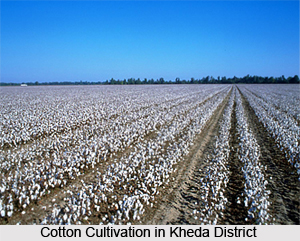 Economy of Kheda district in the state of Gujarat is primarily dependent on the production of tobacco and the cultivation of cotton. Kheda district is also known by the name golden leaf since it is the chief producer of tobacco in the State. Cotton cultivation is in particular popular in Nadiad taluka. Nadiad taluka is the industrial center in the district, with major concentration of industries in sectors like Electrical equipments, Textiles, Paper, and Food processing. One of the leading manufacturers of corrugated boxes in the Country, the Core Emballage Ltd., is present in the district. The upcoming industrial sectors in the district comprise Plastic and its products, Ceramics, Cement and Gypsum.
Economy of Kheda district in the state of Gujarat is primarily dependent on the production of tobacco and the cultivation of cotton. Kheda district is also known by the name golden leaf since it is the chief producer of tobacco in the State. Cotton cultivation is in particular popular in Nadiad taluka. Nadiad taluka is the industrial center in the district, with major concentration of industries in sectors like Electrical equipments, Textiles, Paper, and Food processing. One of the leading manufacturers of corrugated boxes in the Country, the Core Emballage Ltd., is present in the district. The upcoming industrial sectors in the district comprise Plastic and its products, Ceramics, Cement and Gypsum.
There are massive natural gas reserves in Matar taluka of the district. Oil and gas company Shell India Ltd. has its bottling plant and filling services in the district. One of the oldest textile industries - New Shorock Mills (Division of Mafatlal Industries) has its operations at Nadiad. The main fruits cultivated in the district include Citrus, Aonla, Banana and Papaya. Kheda is the biggest producer of Aonla contributing 23 percent to the total production in the state. Kheda contributes 7 percent to the total production of vegetables in Gujarat. The important crops of vegetables in the district include potatoes, tomatoes, brinjal and onions. Major Spices grown in the district include cumin seeds, chilly, ginger, fennel seeds, and turmeric. The district is the second largest producer of Tobacco in the State.
Most important minerals found in the district are bauxite, limestone and quartz. Other minerals obtainable in the district include bentonite, sand, gravel, brick sand, road metal, and black trap. Limestone occurs in Balasinor taluka of Kheda with 800 Million tonnes of reserves, processing having 7 percent shares in total reserves of the State. Bauxite reserves are found in Thasara and Kapadwanj talukas (approximately 89 Million tonnes) and quartz reserves exist in Balasinor and Thasar talukas of the district. Some of the mineral-based industries in Kheda are: Bauxite calcination plant, Cement plant, Glazed tiles, Marble cutting, Bentonite pulverising unit, and polishing and Quartz crushing unit.
Presently there are twenty medium and large scale industries in Kheda district. All these industrial units are concentrated in Nadiad, Mahemdabad, and Kheda and Matar talukas of the district. There are 8,186 small scale industries which operate in the Kheda district. Some of the most important industries under SSI are chemicals, varied manufacturing industries, repairing services, food products and nonmetallic mineral products. The proposal for setting up an integrated textile park in Kheda is expected to boost the industrial and financial growth of the district with augment in employment opportunities and investments in the textile sector. The completion of Ahmedabad- Nadiad Expressway and Nadiad-Vadodara Expressway, two lane dual carriageways with full access control has enabled to save time in commuting between these districts and increase the commercial value of the region because of better convenience.
The budding industrial sectors such as Paper, Cement and Gypsum and Ceramics showed an increasing trend in investments in the last two decades. This would further enhance the industrial expansion and economy of the district. Kheda district has some of the best mineral based industries which offer scope for investments in the mining sector.



















